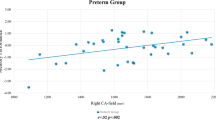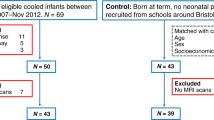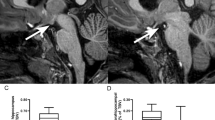Abstract
Objective:
Survivors of neonatal encephalopathy (NE) are at risk for impaired cognition. The objective of this study was to assess speed of processing (SOP) and memory in infants with moderate NE.
Study design:
Sample consisted of 17 infants with NE and 23 healthy controls. Visual-evoked potentials (VEP) were assessed at 8 months to assess SOP. Memory was assessed at 12 months using elicited imitation (EI). Memory and SOP had previously been assessed in this cohort in the newborn period.
Results:
Infants with NE had similar SOP and EI performance as controls. Newborn SOP correlated with 8-month SOP in infants with NE, however, neonatal ERP memory measures were not correlated with EI performance at 12 months.
Conclusions:
Infants with moderate NE treated with TH show preserved memory and SOP through 12 months. Early behavioral and electrophysiologic assessments of memory and SOP provide insight into developing cognitive functions in this risk group.
This is a preview of subscription content, access via your institution
Access options
Subscribe to this journal
Receive 12 print issues and online access
$259.00 per year
only $21.58 per issue
Buy this article
- Purchase on Springer Link
- Instant access to full article PDF
Prices may be subject to local taxes which are calculated during checkout


Similar content being viewed by others
References
Kurinczuk JJ, White-Koning M, Badawi N. Epidemiology of neonatal encephalopathy and hypoxic-ischaemic encephalopathy. Early Hum Dev. 2010;86:329–38.
Shankaran S, Laptook AR, Ehrenkranz RA, Tyson JE, McDonald SA, Donovan EF, et al. Whole-body hypothermia for neonates with hypoxic-ischemic encephalopathy. Hypothermia Perinat Asphyxial Enceph. 2005;353:1574–84.
Azzopardi DV, Strohm B, Edwards AD, Dyet L, Halliday HL, Juszczak E, et al. Moderate hypothermia to treat perinatal asphyxial encephalopathy. N Engl J Med. 2009;361:1349–58.
Gluckman PD, Wyatt JS, Azzopardi D, Ballard R, Edwards AD, Ferriero DM, et al. Selective head cooling with mild systemic hypothermia after neonatal encephalopathy: multicentre randomised trial. Lancet. 2005;365:663–70.
Jacobs S, Morley C, Inder T, Steward M, Smith K, McNamara P, et al. Whole-body hypothermia for term and near-term newborns with hypoxic-ischemic encephalopathy: a randomized controlled trial. Arch Pediatr Adolesc Med. 2011;165:692–700.
Simbruner G, Mittal RA, Rohlmann F, Muche R. Systemic hypothermia after neonatal encephalopathy: outcomes of neo.nEURO.network RCT. Pediatrics. 2010;126:e771 LP–e778.
Zhou W, Cheng G, Shao X, Liu X, Shan R, Zhuang D, et al. Selective head cooling with mild systemic hypothermia after neonatal hypoxic-ischemic encephalopathy: a multicenter randomized controlled trial in China. J Pediatr. 2017;157:367–72.e3.
Azzopardi D, Strohm B, Marlow N, Brocklehurst P, Deierl A, Eddama O, et al. Effects of hypothermia for perinatal asphyxia on childhood outcomes. N Engl J Med. 2014;371:140–9.
Guillet R, Edwards AD, Thoresen M, Ferriero DM, Gluckman PD, Whitelaw A, et al. Seven- to eight-year follow-up of the CoolCap trial of head cooling for neonatal encephalopathy. Pediatr Res. 2012;71:205–9.
Shankaran S, Pappas A, McDonald SA, Vohr BR, Hintz SR, Yolton K, et al. Childhood outcomes after hypothermia for neonatal encephalopathy. N Engl J Med. 2012;366:2085–92.
de Vries LS, Jongmans MJ. Long term outcome after hypoxic-ischemic encephalopathy. Arch Dis Child Fetal Neonatal. 2010;96:F220–4.
van Handel M, de Sonneville L, de Vries LS, Jongmans MJ, Swaab H. Specific memory impairment after NE. Dev Neuropsychol. 2012;37:30–50.
Smith TF, Schmidt-Kastner R, McGeary JE, Kaczorowski JA, Knopik VS. Pre- and Perinatal Ischemia-Hypoxia, the Ischemia-Hypoxia Response Pathway, and ADHD Risk. Behav Genet. 2016;46:467–77. p
Robertson CMT, Finer NN, Grace MGA. School performance of survivors of neonatal encephalopathy associated with birth asphyxia at term. J Pediatr. 1989;114:753–60.
Pfister KM, Zhang L, Miller NC, Hultgren S, Boys CJ, Georgieff MK. ERP evidence of preserved early memory function in term infants with neonatal encephalopathy following therapeutic hypothermia. Pediatr Res. 2016;80:800–8.
Georgieff MK. Nutrition and the developing brain: nutrient priorties and measurement. Am J Clin Nutr. 2007;85(Supplement):000S–000S.
DeBoer T, Wewerka S, Bauer PJ, Georgieff MK, Nelson CA. Explicit memory performance in infants of diabetic mothers at 1 year of age. Dev Med Child Neurol. 2005;47:525–31.
Pfister KM, Gray HL, Miller NC, Demerath EW, Georgieff MK, Ramel SE. Exploratory study of the relationship of fat-free mass to speed of brain processing in preterm infants. Pediatr Res. 2013;74:576–83.
Michalczuk M, Urban B, Chrzanowska-Grenda B, Oziębło-Kupczyk M, Bakunowicz-Łazarczyk A. An influence of birth weight, gestational age, and Apgar score on pattern visual evoked potentials in children with history of prematurity. Neural Plast. 2015;2015:754864.
Chapman DA, Scott KG, Mason C. Early risk factors for mental retardation: role of mternal age and maternal education. Am J Ment Retard. 2002;107:46–59.
Ronfani L, Vecchi Brumatti L, Mariuz M, Tognin V, Bin M, Ferluga V, et al. The complex interaction between home environment, socioeconomic status, maternal IQ and early child neurocognitive development: a multivariate analysis of data collected in a newborn cohort study. PLoS One. 2015;10:e0127052.
Santos J, Pearce SE, Stroustrup A. Impact of hospital-based environmental exposures on neurodevelopmental outcomes of preterm infants. Curr Opin Pediatr. 2015;27:254–60.
Acknowledgements
Funding
: This research was funded by a grant from the Center for Neurobehavioral Development, University of Minnesota, Minneapolis, MN. This study was also supported by the National Center for Advancing Translational Sciences of the National Institutes of Health Award Number UL1TR000114. The content is solely the responsibility of the authors and does not necessarily represent the official views of the National Institutes of Health.
Author information
Authors and Affiliations
Corresponding author
Ethics declarations
Conflict of interest
The authors declare that they have no conflict of interest.
Electronic supplementary material
Rights and permissions
About this article
Cite this article
Zorn, E.P., Zhang, L., Sandness, K. et al. Preserved speed of processing and memory in infants with a history of moderate neonatal encephalopathy treated with therapeutic hypothermia. J Perinatol 38, 1666–1673 (2018). https://doi.org/10.1038/s41372-018-0253-1
Received:
Revised:
Accepted:
Published:
Issue Date:
DOI: https://doi.org/10.1038/s41372-018-0253-1



